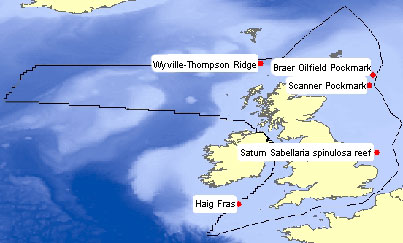 |
|||
Progress and conservation updates Contact [email protected] for more information Valuable deep-sea habitats that surround the UK are often located offshore. Under current legislation these habitats are very difficult to protect, even more so when they lie in international waters, where jurisdiction may be shared between several different countries. The UK's exclusive economic zone (EEZ) extends 200 nautical miles, and encompasses Rockall and parts of the Wyville-Thomson Ridge (See map below). The first offshore marine protected area was designated in 2004. The Darwin Mounds are a series of sandy mounds located 185 kilometres to the north-west of Scotland. The mounds extend over an area of approximately 545 km² at depths of approximately 1000 metres. Based on current knowledge the mounds are unique, consisting of colonies of Lophelia pertusa corals growing on a sand base rather than hard substratum. Discovered in 1998, it took almost 5 years to designate the Darwin Mounds a special area of conservation (SAC). Back then legislation did not extend to the deeper waters offshore. In 1999, Greenpeace moved to change this. In an English High Court judgement, the primary European legislation governing nature conservation, the Habitats Directive, was made applicable out to the 200 nm limit of EU member states EEZ's. The Habitats Directive (92/43/EEC) requires by law that European member states introduce a range of measures to protect habitats and species listed in Annexes I and II respectively. Shortly after the discovery of the Darwin Mounds, evidence of bottom trawling damage became evident. Under a revised Common Fisheries Policy regulation, emergency restrictions can be placed on fishing activity if ".there is evidence of a serious threat [to the marine ecosystem]". In August 2003, at the UK's request, the EU imposed a six-month emergency ban on fishing in the Darwin Mounds area to prevent further damage. The ban was then extended by a further six months whilst the European Commission developed permanent measures to protect the area, this came into effect in 2004. The high court judgement forcing the extension of the EU Habitats directive to the 200nm EEZ has lead to the JNCC ( Joint Nature Conservation Committee ) to proposing five draft Special Areas of Conservation (dSAC's). These include the 'Saturn' Sabellaria spinulosa reef, Haig Fras, Wyville-Thomson Ridge, Scanner Pockmark and the Pockmarks near Braemar Oil field. If these sites become designated SAC's they will form part of the Natura 2000 network (now OSPAR ) of sites extending throughout the north-east Atlantic. |
© All rights reserved Launched 01/09/05
